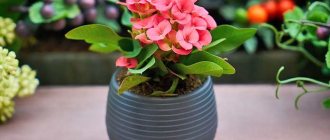In this topic we will talk about favorable colors for the bedroom.
For every person, the bedroom is a special place in the house. This room is for hosts only. In this room we spend a lot of time sleeping or relaxing. It is because of this that the bedroom has a rather intimate character - it is a place where you can relax after a hard day at work and put your thoughts in order. And therefore, you need to choose flowers for the bedroom correctly, which is what we will talk about in this material.
Basic requirements for plants for the bedroom
When a person sleeps, his breathing is deepest. Therefore, the atmosphere formed by green spaces must be clean. Doctors and biologists have formulated a number of criteria based on which they choose indoor plants for the bedroom.
- carbon dioxide absorption;
- release of oxygen;
- hydration;
- dust collection;
- absorption of unwanted impurities from the air;
- correction of the energy background of the bedroom.
As for the aesthetic qualities of green spaces, based on the purpose of the bedroom as a place of relaxation and restoration of vital energy, plants should have:
- subtle, soothing scent;
- calm, not flashy colors.
Such flowers can calm the nervous system that is tired and excited during the day, promoting proper rest.
It is better to choose plants that are unpretentious, can easily tolerate regular ventilation, and do not require a special microclimate or long-term special care. The bedroom should be comfortable, first of all, for the person.
If those living indoors suffer from allergic diseases, then green spaces should not cause allergies.
The soil in the pot and parts of the plant should not become a home for unwanted insects.
Requirements for plants for the bedroom
Let's consider which indoor flowers can be kept in the bedroom, their beneficial qualities and the complexity of care:
- The sleeping area should have very clean air, so improving the microclimate is directly related to the choice of plants that increase the humidity in the room, lower the level of carbon dioxide in the air, neutralize and absorb harmful impurities, produce oxygen, and remove bad energy;
- Due to the frequent ventilation of the recreation area and the fact that a little sunlight penetrates into it, unpretentious and shade-loving representatives of the flora are chosen;
- If anyone in your family has allergies, choose hypoallergenic flowers;
- Indoor plants in a resting place should have a dull color and a subtle delicate aroma. Thus, they have a positive effect on the nervous system and emotional level of a person. Beware of unfamiliar and exotic species with a pungent odor;
- Sick, dying, neglected representatives of the flora have no place in the recreation area.
Sansevieria
It is also called “mother-in-law’s tongue.” A wonderful plant that purifies the air in the bedroom. Unlike many other plants, it produces oxygen rather than absorbing it. Active production occurs precisely at night, which has a beneficial effect on human well-being and health. You just need to take into account that for sufficient oxygen production you need 4-6 pots of plants in one room.
- Produces a large amount of oxygen.
- Easy to care for.
- Tolerates heat well.
- Due to its too strong energy, it is not recommended to place the plant in children's or playrooms.
Selection of plants taking into account the characteristics of the room
Plants are also selected based on the technical parameters of the room:
- area and volume;
- intensity and nature of illumination;
- air exchange indicators.
Room size
In spacious bedrooms with high ceilings, large plants are placed in large pots in shelves or in floor tubs. A lush, developed crown will not clutter up the bedroom. Climbing plants on light partitions would also be appropriate. A good placement option is opposite a full-length mirror on the wall or in a closet door.
Plants for the bedroom are primarily chosen based on the size of the room.
For small-sized bedrooms, including attic ones with a sloping ceiling, it is better to opt for small plantings in hanging flowerpots. The surface of the dressing table would also be a good place to place it. Plants should not interfere with residents moving around the room and doing household chores.
Illumination
If the windows face north, it is better to opt for shade-tolerant or shade-loving plants. Even a little insolation will be enough for them to fully develop.
Windows facing south require the use of light-loving green spaces. They will make full use of sunlight and delight the owner with lush greenery and beautiful flowers.
Western and eastern directions allow you to choose any flower. It is only important to ensure that in summer, when it is hot, they are protected from direct sunlight with light curtains.
Useful plants for the bedroom
If you decide to add greenery to your room, choose auspicious flowers for your bedroom. Avoid plants that smell strongly. Staying in a room filled with aromas for a long time will cause headaches.
Consider the level of lighting in the room and the plants' requirements for its presence. Flowers, like accessories, should be selected taking into account the style of the room.
If you are planning to fill a room with several plants at once, ask how compatible they are and whether they can exist close to each other.
The most useful plants for the bedroom are considered to be: violet, geranium, aloe, camellia, dracaena, laurel, chlorophytum, and begonia.
Favorable indoor plants
Indoor flowers are full of variety. But for the bedroom, representatives of green plants, without a large number of flowers and a cloying aroma, are more suitable:
- Chlorophytum is an excellent air humidifier, which is important for dry heating seasons. The plant also purifies the air from harmful gases, gets rid of microorganisms, and acts as a neutralizer of toxic compounds. To completely clean one room, four of these plants are enough.
- Sansevieria or “mother-in-law’s tongue” has many benefits. This plant produces oxygen both day and night; ideally, 8 leaves are enough for everyone present in the bedroom for maximum beneficial effects - strengthening the immune system, stabilizing blood pressure, and fighting headaches. It does an excellent job of filtering harmful substances such as benzene and formaldehyde, which is perfect for city apartments.
- Spathiphyllum or peace lily is a feminine flower for feminine energy. Along with the active production of oxygen, it perfectly humidifies the air, thus neutralizing microbes dangerous to the respiratory tract. This flower is also responsible for normalizing energy. It also perfectly detoxifies alcohols, acetone, ammonia, benzene, and xylene. Spathiphyllum will provide relief during aggressive aromas from neighbors' renovations.
- Ficus neutralizes harmful toxins by releasing phytoncides into the air, which reduces the risk of viral diseases. It humidifies the air well and enriches the room with oxygen. The leaves of the plant trap dust, which can then be easily removed with a damp cloth. From the point of view of Feng Shui, this plant brings peace and tranquility, which is why it is so valuable for the bedroom.
- Ficus benjamina can relieve stress and normalize sleep. Copes perfectly with odors of household chemicals and finishing materials. Enriches the room with oxygen and promotes air humidification.
- Geranium or pelargonium is a carbon monoxide and chemical neutralizer. Saves from staphylococcus and streptococcus. Has a beneficial effect on the nervous system and respiratory organs. The plant goes well with female energy, thereby having a great effect on hormonal levels. The aroma of the flower perfectly repels insects, however, it can also cause allergies, so before purchasing you need to first check for its absence.
- Hamedorea is a plant that saturates the air with ozone, the smell of freshness. Fills the room with oxygen and humidifies the atmosphere. Along with these properties, it does an excellent job of absorbing toxic mixtures and neutralizing benzene and trichlorethylene.
- Chrysanthemum brings the energy of calm. It releases phytoncides and perfectly absorbs household odors such as cigarette smoke, the smell of plastic, and ammonia. neutralizes formaldehyde.
- Violet stabilizes nervous processes. The psycho-emotional impact depends on the color. White flowers ease nervous breakdowns, relieve stress, purple flowers unite, rid the house of negative energy, and red and pink flowers serve as a source of satisfaction and joy.
- Cactus purifies the air well, and the longer the needles, the better for the bedroom. Fights microbes, reduces air ionization, which is the key to protection against electromagnetic waves.
- Dracaena tones and cleanses the energy, while enhancing positive emotions. It humidifies the air well and enriches the space with oxygen.
- Aloe kills bacteria that cause diseases, making the bedroom atmosphere healthier. Two or three plants are able to maintain excellent immunity during the most dangerous periods. It also absorbs toxic substances from chipboard furniture that is harmful to health (up to 90 percent). From a medical point of view, this plant is also unique. The energy of the plant creates protection from misfortunes and removes electrification, while the plant does not like large numbers of people.
- The “Money Tree” is primarily responsible for the material side, and is a symbol of prosperity, accumulating positive energy. Absorbs negative energy, cleansing the space. It can rightly be called a filter plant, as it neutralizes harmful substances and absorbs odors. Releases oxygen well.
- Begonia, like the money tree, is a symbol of prosperity. The aroma helps cope with depression and illness. The flower is especially recommended for the bedroom of an elderly person. Neutralizes harmful microbes.
- Kalanchoe is an antidepressant plant. Actively releases oxygen, helping to humidify the air.
- Palm tree is a wonderful decorative element for the bedroom. Along with beauty, it enriches the room in which it is located with oxygen and humidifies the air. It is a source of energy of freshness and strength.
- Laurel is a versatile plant. Humidifies and purifies the bedroom air. Calms the nervous system, relieves migraines, intestinal spasms, increases blood circulation, which is good for the brain.
- Citrus fruits - lemon, orange, tangerine, lime - all of them have a beneficial effect on the respiratory system and produce healing substances, which have a beneficial effect on the aura of the room. Kill microbes and reduce their reproduction.
Rosemary
Rosemary
Rosemary is an oil plant. It releases volatile oils that have a powerful bactericidal effect. It is especially recommended by doctors for the bedrooms of those suffering from respiratory diseases. Rosemary vapors have an excellent calming effect.
In addition, rosemary oil and inflorescences are widely used in cooking and folk medicine to treat a wide range of diseases.
The disadvantage of rosemary is its capriciousness and difficulty in caring for the flower.
Lavender
Great for a room where people sleep, lavender is a plant that has a number of beneficial properties. It has a delicate scent and elongated inflorescences of blue and pink shades.
Lavender should be immediately planted in a large pot, because it loves space and freedom. The plant will not bloom in a small container. She loves sunlight very much, so she needs to be placed on window sills, or even better, additionally illuminated.
The aroma of lavender has truly magical properties: it lifts your spirits, relieves depression, relieves nervous tension, headaches, and helps cope with fatigue and insomnia.
Therefore, you can safely plant this plant in a pot and place it in the bedroom. Just choose a variety suitable for indoor cultivation.
Myrtle (myrtle tree)
This is a very suitable plant for the bedroom and has calming and calming properties. In addition, myrtle removes bacteria and tubercle bacilli. Myrtle tree improves sleep, so its presence in the bedroom has a beneficial effect on people.
Caring for myrtle is not difficult; the plant loves sun, moisture and warm air. It sometimes sheds its leaves, thus reacting to unsuitable conditions for it.
After you have purchased a myrtle tree for your room, you definitely need to give it a “rest period” - it should stand on the windowsill for some time until it gets used to the atmosphere around it. After this, it should be moved to a permanent place.
Myrtle may not grow in the sunniest place, but flowers will appear only in the sun. In addition, myrtle loves moist air, so it needs to be moistened as often as possible, including spraying the leaves with water.
Laurel
When considering the question of which indoor flowers can be placed directly next to the bed, it is worth paying attention to the so-called “classic” plants for the home. House laurel is considered one of the best types of home “green friends”, helping to normalize sleep.
Since ancient times, laurel branches have been placed at the head of children's cribs so that the child can sleep soundly and peacefully. The plant purifies the air, has a beneficial effect on the human nervous system, eliminates migraines and cephalalgia, and improves brain activity.
Asparagus
Asparagus
Asparagus, in addition to organic harmful impurities, also absorbs vapors of heavy metals, which can lead to the development of severe chronic diseases. It releases phytoncides; doctors recommend placing the flower in the bedrooms of people suffering from pulmonary and skin diseases. The large area of small cut leaves also serves as an excellent dust collector - the main thing is to remember to wipe it regularly.
Record holders for air purification
- The leader in purifying room air is chlorophytum. It is unpretentious and actively neutralizes bacteria and substances that are harmful to human health. If you water the plant more often, it will humidify the air. If you live in an industrial area, where there is a lot of carbon monoxide and acetone in the air, the flower will cope well with them. It is believed that a large amount of the plant can completely purify the air.
- If the bedroom has a parquet floor, then Dieffenbachia will destroy the toxic substances released by the material. The plant actively fights staphylococci - the causative agents of colds, including sore throat and pneumonia.
- Tradescantia perfectly purifies the air, neutralizes radiation, and humidifies the air.
- Geranium releases biologically active substances that have a beneficial effect on the body.
- Fragrant pelargonium enriches the air with negatively charged oxygen ions.
- Laurel is considered a useful plant, which kills viruses and bacteria.
Plants that help with dry air
Some plants are great at humidifying a room. Plants absorb 1% of water from the ground, the rest evaporates into the air. Preference should be given to moisture-loving species that require regular spraying and watering. Ficuses and ferns will do a great job of humidifying the room, but there is no need to create a garden; a few plants evenly spaced around the room will be enough.
The best indoor flowers to keep in your bedroom:
- chlorophytum;
- geranium;
- laurel;
- aloe;
- eucalyptus;
- rosemary;
- pelargonium;
- reromia;
- Crassula;
- Golden mustache;
- dracaena;
- camellia.
Healing plants
If you think about it, a huge amount of harmful compounds come into our houses and apartments along with furniture and household chemicals.
By placing several pots of geranium, you can improve your nervous system and get rid of insomnia. The main thing is that there is no allergy to the plant.
What flowers can be kept in the bedroom so that they contribute to the treatment of diseases:
- For angina pectoris and diseases of the cardiovascular system, place laurel.
- Aloe helps increase efficiency, physical endurance, activates brain function, and supports immunity.
- Peperomia will help with depression. For chronic bronchitis, myrtle, eucalyptus, and rosemary will be helpful. Plants make breathing easier.
Many people have probably noticed that there are places in the room where well-being worsens and depression can occur. Place ficus or myrtle in this place, they will absorb all the negative energy.
Record holders for air purification
The air constantly contains harmful and sometimes toxic substances, such as compounds of benzene, formaldehyde, trichlorethylene, toluene and xylene. All of them stand out from the furnishings, carpets, plastic windows and wallpaper. Additionally, a person independently saturates the room with chemicals when cleaning using various cleaning products. Correctly and successfully selected plants will purify the air and eliminate all harmful compounds.
Indoor flowers from this list are considered record holders for cleaning:
- Ficus benjamina is a real record holder, neutralizes a lot of chemical compounds and attracts dust;
- Ivy (Hedera helix) – cleanses benzene and ammonia;
- Dracaena – neutralizes formaldehyde fumes;
- Schefflera – neutralizes nicotine and tars contained in tobacco smoke;
- Golden scindapsus (Epipremnum aureum or pothos) – neutralizes benzene.
Any of these plants has a beneficial effect on the atmosphere in the bedroom. You can also place several flowers on the windowsill at once: they get along well together and complement each other.
Which ones are not suitable for the bedroom?
However, not all representatives of the green family are suitable for the bedroom. These include plants of the night - those that are active at night and absorb oxygen, have a strong odor, which threatens allergies, neuroses and nausea, and those that, according to the teachings of Feng Shui , energetically not suitable for the bedroom:
- Orchid . It would seem, why can’t you keep such a delicate and beautiful flower in the bedroom? But, from the point of view of energy and essential oils, this plant is dangerous for sleep. Orchid is dangerous because it provokes insomnia, headaches, an aggressive and irritable state in the morning and depression and fatigue throughout the day.
- Lily . It is harmful due to its excessive absorption of oxygen and large release of carbon dioxide, hence morning headaches and feelings of depression and fatigue. Ferns can also be classified as the same type of sleeping pests.
- Jasmine . Just like lily, it absorbs a lot of oxygen, but in addition to this, its bright smell can cause allergic reactions, nausea and headaches.
- Dieffenbachia . The plant is rich in moisturizing properties, cleanses the air well of phytoncides, but is also very poisonous. Contact of juice on the skin causes severe irritation and itching. Even worse, if the plant gets on the mucous membrane, swelling of the tongue and blindness will be its consequences. These include tuberose, croton, Japanese rhodoea, and oleander.
- Hydrangea . The plant is beautiful, but is fraught with allergic reactions from the aroma and pollen of the plant.
- Monstera . It absorbs energy, thereby literally “suffocating” a person in his sleep, taking away large quantities of oxygen in the bedroom.
- Philodendron . Dangerous from poisoning and damage to the gastrointestinal tract.
- Azalea . A luxurious hat of thick colors is not suitable for the bedroom, as it can cause cramps and even colic and stomach spasms.
- Mimosa and Gesner tulip. They are dangerous for the hair, as they negatively affect the hair follicles, which can lead to hair loss and baldness.
Chlorophytum
A very unpretentious perennial herbaceous houseplant that thrives in both shade and sun. In the light, the color of its leaves becomes brighter. Purifies the air from harmful impurities such as formaldehyde and carbon monoxide.
What do the Chinese say?
In China, as in Rus', symbolism was attributed to flowers. According to the doctrine of the harmonious arrangement of things in space - Feng Shui, indoor plants are not divided into good and bad: each one must be put in its place and it will be beneficial.
Bouquets of cut flowers are welcome in the bedroom according to Feng Shui.
Indoor flowers are not needed for a Feng Shui bedroom, decorated according to all the rules. However, as with everything, there are exceptions.
Instructions for creating a harmonious resting place read:
- There should be no green spaces near the bed;
- Lushly flowering plants have no place in the bedroom - they suppress female vital energy (Qi);
- Flowers with sharp leaves and thorns should also not be placed in the room for sleeping and resting;
- And if there are flowers in the bedroom, then let them be plants that stretch upward.
According to Chinese wisdom, all indoor plants are endowed with a certain energy and influence certain areas of their owner’s life:
- Tradescantia is a mirror flower that reflects the internal energy of the house. If there is discord in the family, the plant turns yellow and dies;
- Ficus – suppresses aggression and neutralizes anxiety;
- Fern – cleanses the home of negative energy;
- Aloe or balsam - promotes reconciliation among relatives or spouses;
- The money tree (crassula) is one of the most famous symbols of material well-being;
- The orchid is a muse for creative people, and it also helps overcome depression.
An exquisite orchid will inspire a creative person.
Kalanchoe
A flower with thick, fleshy leaves that does not require special care. This is a good solution for those who have a love for exotic indoor plants: they have an interesting leaf shape and very beautiful flowering. Kalanchoe blooms once a year, but very abundantly and colorfully. In addition, it belongs to the category of healing indoor flowers, and therefore it definitely won’t hurt to purchase it.
Kalanchoe is not just a healing plant, it can serve as a bright accent to attract attention
Basic recommendations for growing flowers and plants in the bedroom
Indoor flowers for the bedroom require some care and respect.
In order for the process of adaptation of a new plant in the house to be as easy as possible, you should open it and inspect it, remove broken leaves and flowers, and in some cases, perform a transplant.
Dirt and dust from the petals should be removed with a cotton swab. Water the soil if it is dry. You shouldn’t immediately put the flower on the windowsill. For the first week, it is better to avoid direct sunlight.
For plants that love ultraviolet radiation in winter, it is better to get a special “flora” lamp and from time to time let them enjoy a sufficient level of ultraviolet rays.
How to arrange flowers in the bedroom
Of course, the above does not mean that all the listed flowers need to be placed in the bedroom - in order to bring harmony into your life, one or two flowers are enough. The principle here is that it is better not to overdo it.
Flowers in the bedroom can be placed:
- on windowsills if they like bright sunlight;
- on the bedside table;
- on the chest of drawers;
- just on the floor if the plant is large enough.
On a wide windowsill, if you have one in your apartment, you can place several pots of flowers and an elongated container where you can plant suitable plants - for example, begonias of different shades.
If your bedroom has a narrow window sill, you can put several small beautiful pots of geraniums - they will fit perfectly into your interior.
A small neat pot with a flowering plant will look great on the bedside table, especially if it is equipped with lighting. For example, a lavender bush under a lamp will feel great and fill the air with a delicate aroma.
Beautiful pots of flowers can be placed on the chest of drawers, but you just need to choose plants that do not need bright sunlight. Then they will not only look good in the bedroom interior, but will not experience problems with development, which is also important - there is no place for fading, drying flowers in the bedroom.
If you have a plant in your bedroom in a large, beautiful flowerpot, feel free to place it on the floors, choosing a suitable place - flowers on the floor look very stylish if they are correctly integrated into the interior of the room.
Field bouquet
Wildflowers in the bedroom
A bouquet of wildflowers is often kept as a keepsake from a trip to nature. But not all of them are designed for this. Beautiful flowers and a pleasant aroma will not leave a woman indifferent.
Do not put in the bedroom:
- Lily of the valley.
- Dream-grass.
- Jasmine.
- Pansies.
- Immortelle.
- Lilac inflorescences.
- Poppy.
No less beautiful, and not having a detrimental effect on humans, can be called:
- Chamomile.
- Tea rose (rose hips).
- Violet (but not night violet).
- Tulip.
- Buttercups.
- Snowdrops.
- Scillas.
- Carnation.
Even if the impacts are sometimes not obvious, they still exist. Some people boast that they sleep well in the presence of lilies of the valley.
In fact, this can lead to serious health problems in the future, especially if such dangerous flowers have been in the bedroom for a long time.
Jasmine
A beautiful flower that has an unusual property. Scientists from Germany have found that jasmine releases substances that relieve nervous tension, anxiety and anxiety. The flower calms the nervous system, has a beneficial effect on well-being, and ensures healthy and sound sleep. It is also called the “sleepy” flower.
- Improves sleep.
- It has a calming effect on a person.
- Easily tolerates high temperatures.
- Some varieties have a strong aroma. Sleeping with such a flower in the bedroom will be quite difficult and unpleasant. Choose plants that do not have such a strong aroma. And also do not place it near the bed.











